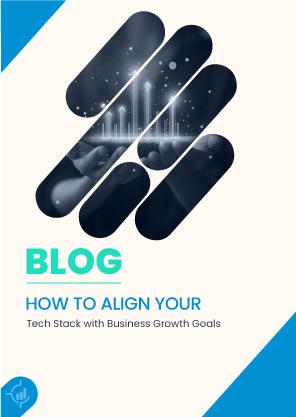or call: +1 (845) 347-8894

or call: +1 (845) 347-8894

Most businesses treat technology like a collection of tools bought on demand, plugged into teams, and expected to deliver. But here’s the truth: a tech stack with business growth isn’t just infrastructure. It’s the backbone of your strategy, the silent driver of speed, scale, and competitive edge.
If your systems can’t grow with your business, they’ll eventually stand in its way. The question isn’t what tools are you using? Do those tools push you forward or hold you back?
This article explores how tech leaders can evaluate, refine, and scale their tech stack with business growth in mind to support real business growth. Whether you’re leading a startup or scaling a global enterprise, these insights can help optimize every layer of your stack, ensuring each tool supports the business’s core intent.
Before selecting platforms or purchasing software, leaders must be clear on the business’s short-term and long-term direction. Technology should never dictate strategy; it should enable it. Start by outlining your company’s core objectives, such as revenue targets, market expansion, operational efficiency, or customer satisfaction.
Are you aiming to enter new geographies? Planning to double the headcount within two years? Do you intend to reduce churn or automate complex internal workflows? These questions frame the purpose of your tech investments.
Once the vision is mapped, align each layer of your tech stack accordingly. For instance, a business planning for rapid expansion may prioritize cloud-first solutions with modular design. Meanwhile, companies looking to streamline support operations may lean into AI-driven customer platforms. One such company is Zendesk for optimizing customer support and driving operational efficiency.
Technology should function as a bridge between your strategic ambitions and operational delivery. If it becomes a bottleneck, it’s a sign of misalignment.
A thorough tech audit is not about listing your current software, but it’s about measuring impact. Start by cataloging each platform your team uses, from CRM to analytics to workflow automation. Then assess three core aspects: usage, utility, and scalability.
Gaps often show up when people don’t fully use a tool or when the software doesn’t work well with other systems. For instance, if your sales tool isn’t connected to your CRM, you might miss chances to follow up or end up with scattered information.
Another sign of misalignment is duplicate functionality. If two systems serve the same purpose, you may be draining budgets without gaining extra value. Every dollar spent should bring measurable improvement to operations or decision-making.
This audit process also creates a foundation for rationalizing your investments. Teams often realize they’re paying for features they never use or platforms they outgrew years ago.
No tool works alone. Even the smartest software can fall short if it doesn’t work well with others in your stack. A tech stack with business growth in mind ensures seamless integration across platforms.A disconnected setup adds confusion, slows decisions, and may increase security risks.
Pick systems that offer strong APIs and ready-made connectors. These help move data smoothly between tools, key for things like sales planning, marketing tracking, or customer reports.
Good integration turns insights into action. For example, linking your CRM with marketing tools gives reps a clear view of how prospects are engaging. In the same way, tying support tools to feedback systems helps teams spot common requests or repeated issues.
When your tools talk to each other, you save time and cut errors. This not only speeds up work but also builds trust across your teams.
As businesses grow, needs change, and the demand for a tech stack with business growth becomes even more crucial. This is where modular and cloud-native platforms shine.
Modular solutions allow you to deploy only the features you need, while retaining the flexibility to add more as your needs mature. These tools reduce technical debt and prevent the “rip-and-replace” cycle that often stalls digital transformation efforts.
For instance, instead of investing in a monolithic ERP system, companies are now choosing microservices-based platforms that integrate with existing tools. This keeps costs manageable while maintaining agility.
Scalable platforms also bring continuity. As new departments, teams, or offices come online, you won’t have to revisit core systems. That stability helps maintain momentum during rapid growth cycles.
A tech stack only delivers value if people use it well. No matter how powerful a system is, poor adoption will kill its impact. The path to alignment must include user enablement as a core step, not an afterthought.
Train your workforce not just on features, but on how those features align with company outcomes. Why does this tool matter? How does it improve their workflow? Where can they see quick wins?
Adoption isn’t just about onboarding; it’s about engagement over time. Create a feedback loop where users can share suggestions, report friction points, and request improvements.
Some firms even appoint “tech champions” within each team of employees who lead by example and guide peers in using tools effectively. When adoption is driven from within, the stack becomes more like a culture rather than a system.
As the stack grows, so does your attack surface. Every new tool introduces potential risks like data leaks, access issues, and compliance gaps. A robust governance framework is critical to protect both assets and reputation.
Start by implementing role-based access control. Ensure that team members only access what they need. Next, monitor vendor compliance. Do your vendors adhere to standards like ISO 27001, SOC 2, or GDPR?
Regularly update internal policies for data usage, storage, and third-party integrations. If a vendor changes their terms or is acquired, revisit your risk assessment.
It’s also wise to centralize identity management. Using Single Sign-On (SSO) and Multi-Factor Authentication (MFA) adds protection without slowing access. These steps build trust not just with regulators but also with customers and partners.
A secure stack is not a burden, it’s an enabler of growth. When people trust your systems, they move faster, think bigger, and innovate without hesitation.
Alignment is not a one-time project. As business requirements change, your tech stack should adapt accordingly. Measuring ROI should go beyond costs saved. Think about time gained, risks reduced, leads generated, or decisions improved.
Establish clear KPIs tied to each tool. For example:
Review performance every quarter. Involve stakeholders across departments and create a forum for honest feedback. Did the tools support recent growth milestones? Were there any roadblocks caused by technical limitations?
Be open to iteration. Sunset tools that no longer serve a clear purpose. Try new ones when gaps emerge. Flexibility in managing your stack is key to staying aligned with growth goals over time.
Tech stacks are not trophies. They are working systems that should evolve as your business does. When aligned well, they don’t just support your goals but accelerate them.
By grounding your stack in the business vision, ensuring integration, focusing on adoption, and continuously reassessing its impact, you create an infrastructure that fuels both performance and innovation.
In the end, it’s not about having the most tools. It is about having the right tools—connected, scalable, secure, and closely aligned with your business needs.
1. How often should a company audit its tech stack?
Ideally, conduct a full audit once a year, with light reviews each quarter to track performance, security, and alignment with business goals.
2. What’s the first sign that a tech stack is misaligned?
A: Low adoption across teams, duplicated tools, or difficulty accessing integrated data are early signs of misalignment.
3. Should small businesses invest in scalable tools early?
Yes, but smartly. Start with modular tools that grow with you. Avoid heavy systems that require complex setup unless necessary.
4. How important is user training in tech stack alignment?
Critical. Tools are only as valuable as the way they are used. Regular training ensures tools deliver on their intended promise.
5. What’s the role of IT in stack alignment?
A: IT teams act as custodians of governance, security, and integration. Their insights are crucial in evaluating risks and maintaining performance standards.
To participate in our interviews, please write to our IntentTech Media Room at sudipto@intentamplify.com




